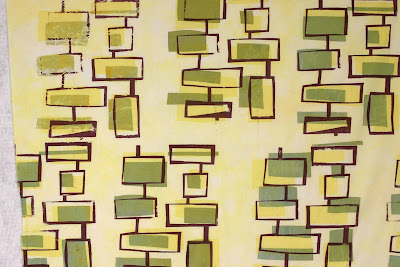These first two pieces are some green that I had mixed up and some gold/yellow/brown that I combined. The green looked pretty awful when wet but got much better when it was dry. Usually I like the colors better when they're wet, so this was a surprise.

The one on the right is fuchsia (no surprise); the one on the left is scarlet. I love red.
This was the surprise. The dye color is Deep Cherry and in the dye pot it looked nearly black. The wet fabric looked very very dark purpley-red and rich. The dry result is less so and is destined to be the base for something else. I don't much care for this color. The light grey piece was dyed in the same container but added after about 15 minutes had passed (like Ann Johnston's parfait method). It looked lilac when wet, but all of the red washed out and the fabric is a lovely grey. (Eat your heart out, Linda in Belgium!) This was a reminder that red always fixes very quickly and isn't be available in subsequent layers of parfait dyeing.
I had 4 different blues left over: navy, intense blue, turquoise, and I don't remember the name of the 4th one. I always have lots of blue left over because it's the color I use least when dyeing. So why do I mix up so much? Can't resist having a selection. And blue is necessary for green and gold and purple; I just have to remember that I need relatively less blue than I need red and yellow.
These last two pieces were done with screen printing, using 3 different screens. I cut stencils from newsprint. The first one was the outline of the connecting squares. The other two were the squares that were slightly offset from the outlines and also sized and positioned so that they didn't quite fit inside the boxes. I like how these turned out, but I did them on white fabric and there was too much white. I put each of them in a very dilute yellow solution just to take the edge off the white.




I'm thinking that I will make some thermofax screens of these boxes and outlines. This kind of stuff is quicker to do with paints because there isn't the batching time that's needed with dyes. Also, doing these designs with dyes meant I had to wait to let the dye paste dry enough that it wouldn't blur when more layers were added, a step that isn't necessary with paints because they dry so fast.
The real surprise was in one of my dye containers. I have a collection of 1/2 gallon sized plastic milk containers with the tops cut off that are terrific for the layered dye method. They're stored in the closet, which is next to the crawl space, home to various and sundry uninvited wildlife. Imagine my delight when I found a mummified mouse in the bottom of one of the containers. Must have fallen in and couldn't get out. At least it wasn't a snake. Yuck.






